January 13, 2022
by Carole Zangari -
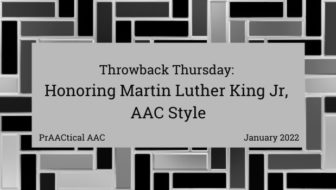
In just a few days, people around the US will be taking time to honor the slain civil rights leader, Dr. Martin Luther King, Junior. If you are looking for ideas to mark the occasion with an AAC flair, take a look at some of the posts below. PrAACtically Martin Luther King, Jr Day PrAACtically Martin Luther King Jr Day: AAC Learning Suggestions It’s PrAACtically Martin Luther King Jr Day Martin Luther King, Jr Holiday: 5 Resources for AAC Learners
Filed under: Featured Posts, PrAACtical Thinking
January 11, 2022
by Carole Zangari -
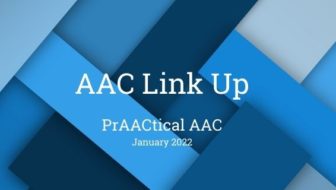
Happy Tuesday, AAC friends! Once a week we invite you to share your own AAC-related content, product news, or anything else that you’d like others in the AAC community to know about. It may be a recent post you’ve written, a slide deck from your AAC presentation, a handout, video, or meme that you’ve posted online, an AAC product you’ve created, an announcement for an AAC course or conference, or any other prAACtical content you developed and want to share with the AAC community. To post your own link, scroll all the way down to the bottom of this post and complete the form. Enter the URL and the name/title in the boxes provided below. If you are on a mobile device, click over to the full website version to do this. The AAC Link Up is moderated to keep us from being spammed so it may take a little... [Read More...]
Filed under: Featured Posts, PrAACtical Thinking
January 10, 2022
by Carole Zangari -
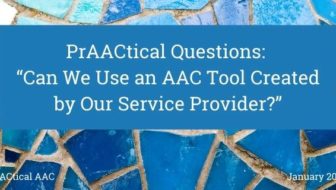
In some areas of the country, professionals and school districts are creating their own no-tech AAC systems. These are usually focused on core vocabulary and are often fairly similar to things that are commercially available. There are several reasons that schools or clinical practices might create their own tools, such as having consistency across classrooms so that staff can learn the tool well and focus their efforts on strong implementation practices. Along with the advantages, there are a number of drawbacks to consider in your decision-making. Here are some considerations in determining whether to use locally-created AAC materials. Examine the words that populate the system. Are the words, phrases, and/or sentences on their AAC tool a good fit for the learner in question? Look at the size of the vocabulary it offers. Are there enough words? Review the vocabulary layout to see how words are organized. Does it facilitate language... [Read More...]
Filed under: Featured Posts, PrAACtical Thinking
January 9, 2022
by Carole Zangari -
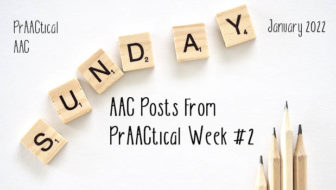
Happy Sunday, AAC friends! Here are some posts you might like. Don’t miss the Spanish AAC resources. Monday – Top 10 AAC Videos of the Year Tuesday – AAC Link Up Wednesday – Video of the Week: Dealing with Emotions, AAC Style Thursday – Improving Assessment Practices for Students Who Use AAC: Mobilizing the Power of Social Narratives Friday – PráctiCAAmente Conectados Con Links – Enero 2022 ::::::::::::::::::::::::::::::::::::::::::::::::::::::::::::::::::::::::::::::::::::::: Before you go, take a look at some of these past posts from the AACtual Therapy series. AAC, Literacy, & Squishy Books Making Core Words Fun for Students with Autism AAC Intervention for Beginning Communicators: Presume Competence and Be the Fun Building Language and Emergent Literacy Skills with ‘Do You Wear Diapers?’ Informal Assessment Activity with Jeanne Tuthill
Filed under: Featured Posts, PrAACtical Thinking
January 6, 2022
by Carole Zangari -
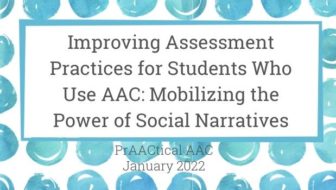
Social narratives are an empirically supported intervention that can be helpful in supporting people with AAC needs. They are commonly used to help individuals with autism understand and deal with challenging situations such as fire drills, birthday parties, and trips to the dentist. All types of social narratives can be written in text alone or include pictures and illustrations. Social Stories are a particular kind of social narrative that have a specific set of guidelines for their development and use. The originator of Social Stories, Carol Gray, defines Social Stories this way: “A Social Story accurately describes a context, skill, achievement, or concept according to 10 defining criteria. These criteria guide Story research, development, and implementation to ensure an overall patient and supportive quality, and a format, ‘voice’, content, and learning experience that is descriptive, meaningful, respectful, and physically, socially, and emotionally safe for the Story audience (a child, adolescent,... [Read More...]
Filed under: Featured Posts, PrAACtical Thinking
January 3, 2022
by Carole Zangari -
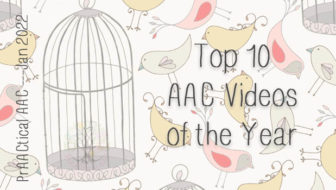
Before we get too far into the new year, we thought you might like one last look at some of the most popular AAC videos of 2021. AAC Modeling at Home Supporting Core Vocabulary in a Life Skills Classroom Ethical Issues in AAC Relationships and AAC TELL ME: AAC in the Preschool Classroom Calendar Time & Weather Report, AAC Style Talking About Feelings AAC Evaluations Teaching Language in the Classroom to Students Who Use AAC Comprehensive Literacy Instruction in AAC Do you have a favorite that didn’t make the list? We’d love to hear about it.
Filed under: Featured Posts, PrAACtical Thinking
January 2, 2022
by Carole Zangari -
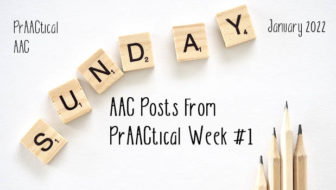
Happy New Year, AAC friends. Here are some posts to ease you into 2022. Monday – January Year of Core Vocabulary & School Year of Core Vocabulary Words Tuesday – AAC Link Up Wednesday – Video of the Week: Making AAC Devices Relevant with Customization Thursday – The Year’s Top AAC Posts: 2021 :::::::::::::::::::::::::::::::::::::::::::::::::::::::::::::::::::::::::::::::::::::::::::::::::::::::::::::: Before you go, here are some posts to explore from our ‘How I Do It’ series. Pocket Flipbooks for Teens & Adults (Intro), Part 1 and Part 2 A Year of Core Words in Action Addressing the 4 Most Overlooked Operational Skills for High-Tech AAC Users Using Visual Supports to Build Attention and Cooperation Starting AAC with Teens & Young Adults by Angela Adams
Filed under: Featured Posts, PrAACtical Thinking
December 30, 2021
by Carole Zangari -
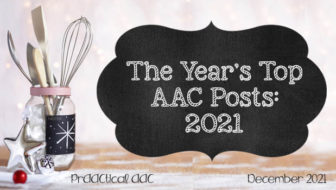
As we wave goodbye to December and welcome the New Year, let’s revisit some of the most popular posts of 2021. PrAACtical Goals That Matter How I Do It: Writing IEP Goals for Students Who Use AAC with Lauren Enders PrAACtical AAC Goals How I Do It: Using PODD books and Aided Language Displays with Young Learners with Autism Spectrum Disorder AAC Assessment Forms Building Your AAC SLP Toolkit: Obtaining Free Apps for AAC Evaluations The First 12: Getting Started with Core Vocabulary Teaching Core Vocabulary Literacy for Everyone with Adapted Books A Year of Core Vocabulary Words Make It Monday: Manual Communication Boards with Core Vocabulary Communication Boards: Colorful Considerations School Year of Core Vocabulary Words: AAC Resources for Month 1 (August) by Michaela Sullivan, Alisa Lego, & Beth Lytle Do you have a favorite that didn’t make the list? We’d love to hear about it.
Filed under: Featured Posts, PrAACtical Thinking
December 27, 2021
by Carole Zangari -
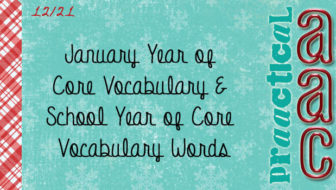
Looking for resources to support core vocabulary instruction? The Year of Core Vocabulary Words and The School Year of Core Vocabulary Words, two series of monthly resources for core vocabulary teaching, remain popular with therapists, educators, and families. We’re reprising those posts for anyone interested in following along and utilizing the resources developed by quite a few people in the AAC community. The initial series was based on a small set of core words for each month (see that post here). We followed that with a second set of Year of Core Vocabulary Word resources for a new list of words (click here for that post). Among the many resources are the activity calendars created by AAC SLP and co-founder of Talking AAC, Rachael Langley. There were many other contributors over the years who added to these efforts. The School Year of Core Vocabulary Words, authored by guest contributors Michaela... [Read More...]
Filed under: Featured Posts, PrAACtical Thinking
December 26, 2021
by Carole Zangari -
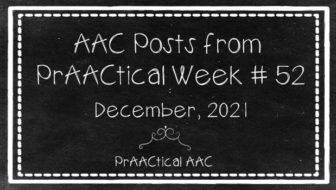
Happy Sunday, AAC friends. Here are some posts you may have missed during the busy holiday week. Monday – AAC Devices & Apps Without an Evaluation: A Few Questions to Ask Tuesday – AAC Link Up Wednesday – Video of the Week: Text-based AAC Thursday – An AAC Christmas Tradition ::::::::::::::::::::::::::::::::::::::::::::::::::::::::::::::::::::::::::::::::::::::::::::::::::::::::: If you have some extra time, stick around and check out these posts from the archives. Holiday Talk: AAC Conversations Using Partner-focused Questions Holiday Photos in AAC Learning: 3 Ideas for Using Them to Build Language Teaching Prelinguistic Communication to Beginning Communicators 5 Resources for Your AAC Toolkit Beginning Communicators: Learning Through Touch Cues
Filed under: Featured Posts, PrAACtical Thinking









